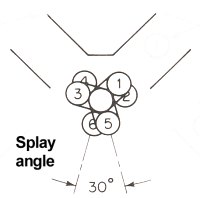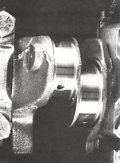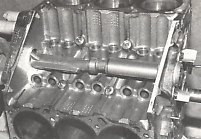Inline 6-cylinder
engines

As shown in the picture,
straight-6 engine is simply two 3-cylinder engines mated symmetrically
together, thus piston 1 is always in the same position as piston 6, piston
2 the same as piston 5 .... in other words, the engine is balanced end-to-end
and requires no balancer shaft, unlike 3-cylinder engines.
What about vertical / transverse
forces? like 3-cylinder engines, the vertical and transverse forces generated
by individual cylinders, no matter first order or second order, are completely
balanced by one another. The resultant vibration is nearly zero, thus inline-6
is virtually a perfect configuration.
Inline-6 is not the only
configuration can deliver near perfect refinement, but it is the most compact
one among them. All boxer engines are perfectly balanced, but they are
two wide and require duplicate of blocks, heads and valve gears. V12 engines
also achieve perfect balance, but obviously out of the reach of most mass
production cars. Automotive engineers knew that long ago, that’s why you
can see most of the best classic engines were inline-6, such as Rolls-Royce
Silver Ghost, Bentley Speed Six, Mercedes SSK, many Bugattis, Jaguar XK-series
and BMW’s various models.
V6 engines
V6 engines, excluding Volkswagen’s
15° VR6 (to be discussed later), are not just made from splitting inline-6
into two banks arranged in V-shape. A V6 has a very different crankshaft
- only 4 main bearings instead of 7. In other words, between two adjacent
bearings there are crank throws for 2 cylinders, one from bank A and another
from bank B. While V8 engines have those 2 cylinders shared the same crank
pin, V6 engine has to split the crank pin into two pieces, with a splay
angle between those pins (30° splay angle for 90° V6; 60° splay
angle for 60° V6). These are shown in below.
 60° V6 with 60°
splay angle
60° V6 with 60°
splay angle
|
 90° V6 with 30°
splay angle
90° V6 with 30°
splay angle
|
 Split crank pins with
a 30° splay angle
Split crank pins with
a 30° splay angle
|
For better balance, most
V6s are arranged such that the banks are placed at either 60° or 90°
to each other. In this way, the movement of cylinders in bank A matches
those in bank B, thus there is no vibration generated between banks. Besides,
like 3-cylinder engines, there is no vertical and transverse vibration.
However, both 60° or
90° V6s have somewhat end-to-end vibration like 3-cylinder engines,
especially is for 90° V6. (sorry, I don’t have the theory) It needs
a counter-rotating single balancer shaft, at crank speed, to suppress the
vibration. The balancer shaft is located inside the V-valley, so it is
not space engaging. On the other hand, 90° V6 has a decisive advantage
in production point of view - it can be machined in V8’s production line
because both of them are 90°. (unlike V6, V8 can only be optimised
at 90°) This save a lot of production cost. An example is Mercedes’
supersmooth 2.4 to 3.2-litre V6s, which share the same architecture with
V8s but added with a balancer shaft.
 End-to-end vibration
End-to-end vibration
|
 Single balancer shaft
inside the V-valley
Single balancer shaft
inside the V-valley
|
60° V6 is smoother to
the extent that, with adequate design engine mount, most of them could
be made nearly as smooth as inline-6 engines without the need of balancer
shaft. It is also narrower, so easier to be packaged into a FWD cars, mounted
transversely.
60° V6 versus Inline-6
As space efficiency becomes
more and more important, most car makers favour V6. The most influential
V6 was perhaps Alfa Romeo’s 2.5-litre 60° V6 used in the GTV6. It established
a reputation for V6 that it can be compact, powerful and smooth. An equivalent
inline-6 would have never fit the small and sloping engine compartment
of that car. Compare the shape of BMW with the Alfa and you’ll know the
packaging advantage of V6s.
Straight-six engines are
nearly impossible to be used in front-wheel drive cars as well. Even a
car as wide as Volvo S80 has to introduce the world’s shortest gearbox
in order to make space for the 2.9-litre straight-six mounted transversely
in the engine compartment.
Longitudinal mounted inline-6
doesn’t have such problems, but it engages too much space in north-south
direction, thus engage some space which would have contributed to cockpit
room.
However, BMW is still loyal
to inline-6 engines. Ultimately, inline-6 engine is more efficient yet
smoother. V6 has more energy loss because it duplicates valve gears and
camshafts (which increase frictional loss), while the use of 2 cylinder
banks leads to more heat loss. In terms of production cost, although V6
has 3 fewer main bearings, it has more valve gears - which is getting more
and more costly these days, with the introduction of twin-cam, hydraulic
tappets / finger follower and variable valve timing. Inline-6 is going
to be cheaper than equivalent V6.





